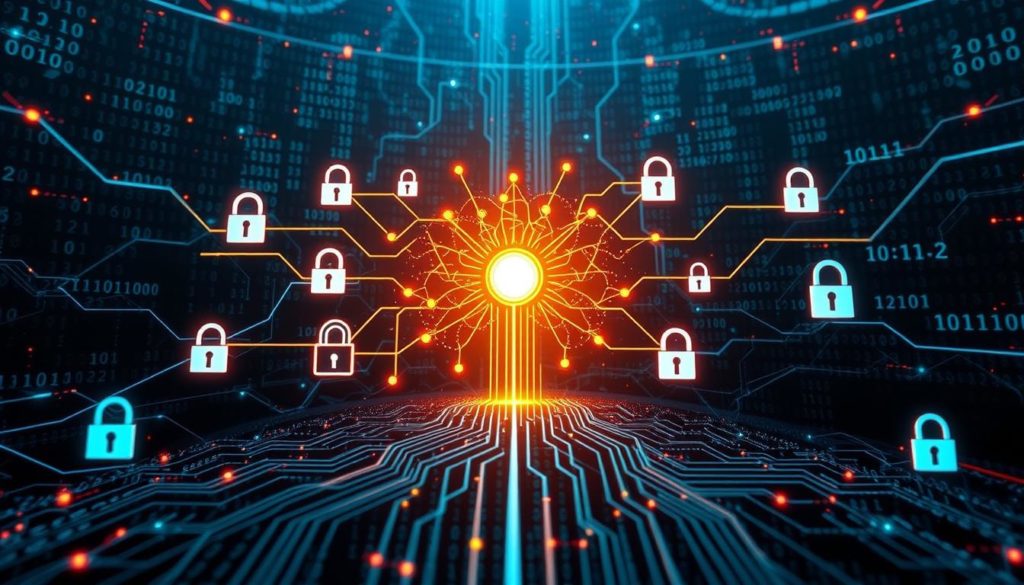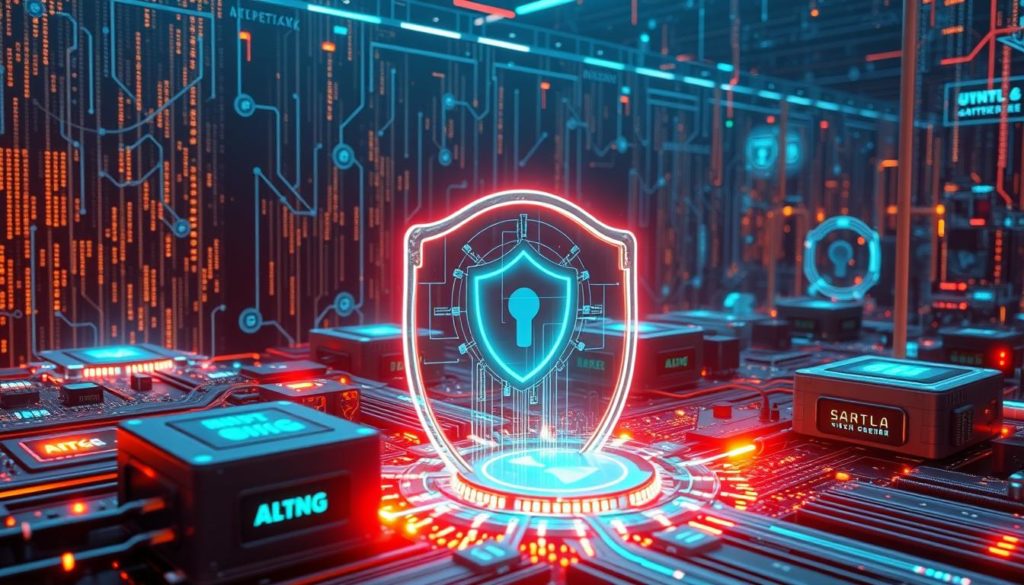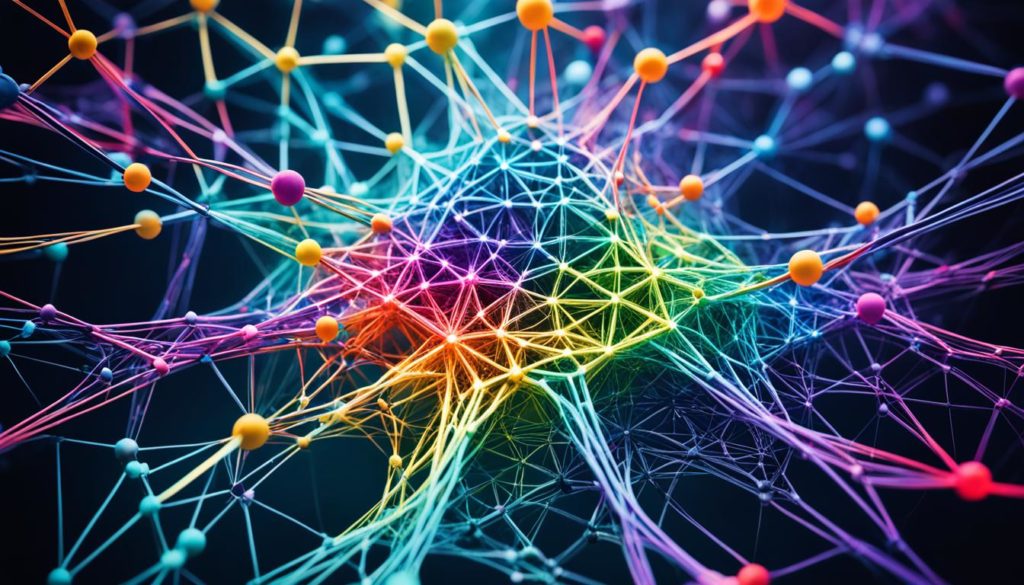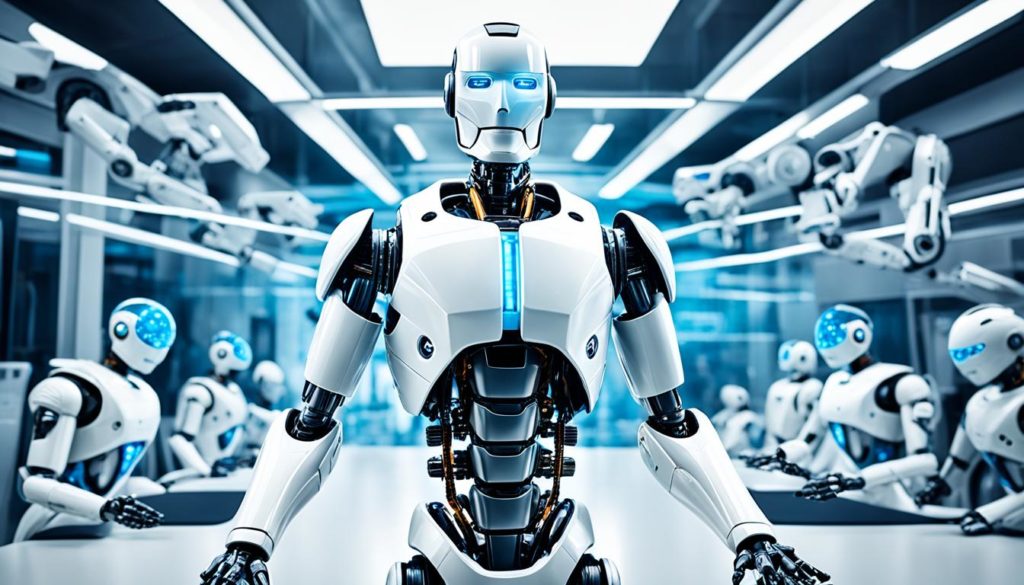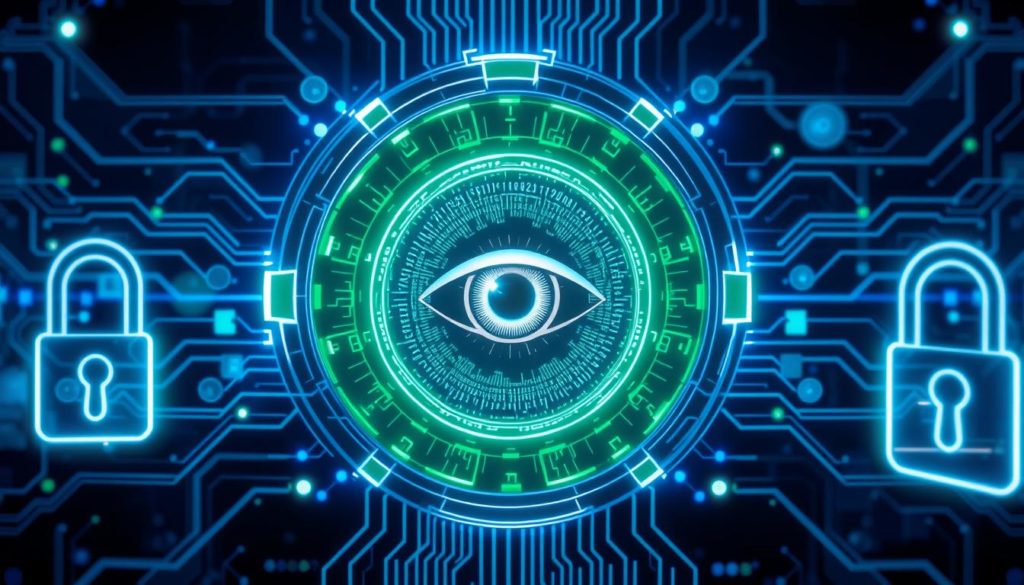
Did you know that companies with AI and automation in security save about USD 3 million on data breaches? In today’s world, digital threats keep changing. AI in cybersecurity is key to keeping our online world safe. It watches, detects, and fights cyber threats all the time.
AI in cybersecurity fights the growing number of cyber attacks. It uses machine learning and natural language processing to quickly go through lots of data. This helps experts spot threats fast and stop them before they cause harm.
AI can also make risk analysis faster by 55%. This is a big help when time is of the essence. As cybercriminals get smarter, AI helps us keep up and fight back. For example, AI can stop phishing, malware, and other bad stuff, keeping our systems safe.
Key Takeaways
- Organizations with fully deployed security AI experience significant data breach cost reductions.
- AI-powered risk analysis can speed up alert investigations by 55%.
- AI systems effectively prevent phishing, malware, and other malicious activities.
- Machine learning and natural language processing enhance threat detection capabilities.
- Advanced AI security measures ensure continuous monitoring and swift incident response.
Introduction to AI in Cybersecurity
Our use of digital tools is growing fast. This makes learning about AI in cybersecurity very important. Cybersecurity AI solutions are vital for protecting us from new cyber threats. AI uses algorithms to quickly spot patterns and oddities in data, just like humans but much faster.
What is AI in Cybersecurity?
AI in cybersecurity uses tech like machine learning and computer vision to keep our digital world safe. These smart tools learn and make choices based on data. They help find and deal with threats by understanding patterns and visual data.
The Importance of AI in Modern Cybersecurity
The world of cyber threats is getting bigger. This makes AI in cybersecurity very important. AI can handle huge amounts of data to learn and spot threats. It helps in many areas like keeping track of devices and predicting attacks.
Cybersecurity automation also helps by filling the gap in security teams. It reduces mistakes and makes responses quicker. AI makes these processes faster, helping security teams make quicker and smarter choices. This shows AI is key to better cybersecurity.
Key Technologies in AI for Cybersecurity
AI in cybersecurity is powered by key technologies. These include machine learning, natural language processing, and computer vision. They change how we fight cyber threats. Let’s explore how these technologies boost our defense.
Machine Learning (ML)
Machine learning is crucial in cybersecurity. It spots threats early by analyzing data in real-time. ML finds odd patterns that might mean a cyber attack, like malware or phishing.
This method predicts threats and automates tasks. It lets us focus on bigger strategies.
Natural Language Processing (NLP)
Natural Language Processing (NLP) lets computers understand human language. It’s key in keeping communications safe. NLP can catch phishing emails and analyze text threats.
It also watches social media for danger. With NLP, AI tools can sift through text to find hidden threats.
Computer Vision
Computer vision lets AI systems understand visual data. It spots suspicious activities online. For example, it can check if someone is who they say they are.
It also watches videos and images for threats. This helps keep digital spaces safe.
Benefits of AI in Cybersecurity
Artificial intelligence (AI) is changing the game in digital security. It helps organizations stop cyber attacks and respond quickly to incidents. This makes our digital world safer.
Advanced Threat Detection
AI-powered threat detection systems are a game-changer. They analyze huge amounts of data to spot complex attacks. This means they can find threats faster and with fewer false alarms.
These systems get better over time. They use advanced algorithms and machine learning to keep improving. This leads to better threat detection and protection.
Automating Security Tasks
Cybersecurity automation is a big win. It frees up human teams from boring, time-consuming tasks. AI handles tasks like threat hunting and scanning vulnerabilities.
This lets security experts tackle harder, more important issues. It makes their work more efficient and reduces mistakes.
Improved Incident Response
AI-driven threat detection makes incident response better. AI quickly analyzes data from many sources. It can start responding to threats before they happen.
This fast action reduces the damage from cyber attacks. AI also gives us insights to prevent problems before they start.
Adding AI to cybersecurity makes our defenses stronger. It helps us handle big data and learn from it. This makes our digital world safer and more resilient.
| Benefit | Description |
|---|---|
| Advanced Threat Detection | Intelligently analyzing data to identify and respond to potential threats in near real-time. |
| Automating Security Tasks | Offloading repetitive tasks from human teams, allowing focus on strategic issues. |
| Improved Incident Response | Enhancing response times and predictive insights to mitigate risks preemptively. |
Applications of AI in Cybersecurity
AI is changing how we protect digital spaces. It’s especially good at AI-driven threat detection. AI uses smart algorithms to spot patterns in big data that might mean trouble. This is key because cyber threats are getting faster, more complex, and more common.
AI-enhanced systems also help with risk assessment and management. They give detailed insights into weaknesses, helping companies focus on the most important fixes. This is crucial for keeping up with the latest cyber attacks.
AI is great at handling and analyzing lots of data. As companies grow, they need to watch more things. AI can grow with them, keeping everything safe. It also keeps learning, so it stays good at fighting new threats.
AI is also good at quickly finding and fixing threats. This means companies can act fast when they find danger. AI helps security teams by doing routine tasks, so they can tackle harder problems.
AI gets even better at finding weaknesses with machine learning. These algorithms can spot new patterns in data. This helps AI work faster and better than old methods, catching threats early.
The rise of dark AI shows why we need strong AI in cybersecurity. Dark AI is when bad guys use AI to attack faster and smarter. Tools like IBM Watson and CybergGraph by Mimecast show AI’s power in fighting cyber threats. They’re very good at finding and fixing problems.
AI is also very adaptable. It keeps getting better by learning from past attacks. This means AI stays ahead of threats, keeping us safe.
In short, AI is key in keeping our digital world safe. It helps us find threats fast, handle lots of data, and keeps learning. AI-driven threat detection and AI-enhanced systems are changing how we protect ourselves online.
AI in Cybersecurity: Case Studies and Examples
Looking into how AI boosts cybersecurity, we see many success stories. AI helps spot complex threats and automates routine security tasks. These solutions are crucial for keeping systems safe.
Real-World AI-Driven Solutions
Snorkel Flow is a great example of AI in cybersecurity. It tackles the problem of not enough training data for cyber threats. Instead of manual labeling, it uses automated methods. This makes it faster and more efficient.
AI also shines in real-time threat detection. Cybersecurity firms use machine learning to quickly scan network traffic. This leads to quicker detection of threats, cutting down response time by up to 90%.
Success Stories in Cyber Threat Prevention
AI has also made a big difference in fighting cyber threats. IBM uses AI to stop social engineering and phishing attacks. This not only boosts security but also frees up teams to focus on more important tasks.
Using AI also saves money. Companies with AI tools spend less on each breach, dropping from about $7 million to $3 million. This is a big advantage over those without AI.
Here’s a quick look at how AI changes things in cybersecurity:
| Aspect | With AI Solutions | Without AI Solutions |
|---|---|---|
| Cost per Breach | $3 million | $7 million |
| Detection Time | Up to 90% faster | Significantly Slower |
| Scalability | Highly Scalable | Limited |
| Workforce Utilization | Efficient | Labor-Intensive |
These examples show how AI greatly enhances our defenses against cyber threats. For more on companies like Snorkel Flow leading this change, check out here.
Challenges and Risks of AI in Cybersecurity
AI has made big strides in cybersecurity, but we must face the risks and challenges it brings. By tackling these issues, we can strengthen our cybersecurity and fight off threats.
Potential for AI Manipulation
Cybercriminals might try to trick AI systems. They could use AI to find weaknesses that humans miss. For instance, deepfake tech has gotten better, making fake videos and audio sound real.
This is a big cybersecurity AI risk because it can lead to better phishing and social engineering attacks. AI can also help with DDoS attacks by flooding a site with traffic. And, AI can make ransomware attacks more effective by finding targets and exploiting weaknesses faster.
Implementation Challenges
Putting AI into cybersecurity isn’t easy. It’s hard to make AI work with current security systems. It also takes a lot of resources and can be complex.
Understanding AI can be tricky, which might lead to false alarms or misses. There are also issues with AI being tampered with or biased. Plus, there are rules and ethics to follow.
Need for Skilled Professionals
There’s a big need for people who know how to use AI in cybersecurity. The industry is short on skilled workers. This makes it hard to use AI tools well.
To keep up, we need to train and update our teams. The cost of using AI means we need to invest in education. This way, our cybersecurity team can handle new threats and keep our defenses strong.
Conclusion
AI is changing how we protect our digital world. Companies are quickly using AI to handle big data and spot threats. AI uses machine learning and analytics to find threats that humans might miss.
AI also helps respond to security issues fast, reducing damage from breaches. It makes security systems smarter and more efficient. This new approach offers better protection and helps systems grow stronger against new threats.
But, there are challenges in using AI for security. There’s the risk of attacks, setting it up can be hard, and finding skilled people is tough. To make the most of AI, we need to keep learning and working together.
By combining AI with human skills, we can make sure AI is used right. This will help keep our digital world safe for everyone. The future of AI in security looks bright, helping us build a safer online space.
FAQ
What is AI in Cybersecurity?
AI in cybersecurity uses artificial intelligence to protect against cyber threats. It includes machine learning, natural language processing, and computer vision. This technology helps keep systems safe by acting like human intelligence.
How does AI benefit cybersecurity efforts?
AI helps by finding threats in big data sets quickly. It also automates tasks, letting experts focus on harder problems. This makes responses faster and more effective.
What are some key technologies in AI for cybersecurity?
Key technologies are Machine Learning, Natural Language Processing, and Computer Vision. Machine Learning spots patterns and makes predictions. Natural Language Processing understands human language. Computer Vision looks at images to find threats.
Can AI help in automating security tasks?
Yes, AI automates tasks like threat detection and data analysis. This makes work more efficient and lets experts tackle harder challenges.
What are some real-world examples of AI-driven solutions in cybersecurity?
AI systems can stop social engineering attacks and protect passwords. They also detect phishing. These examples show AI’s power in keeping networks and data safe.
What is the potential for AI manipulation in cybersecurity?
AI can be used for good or bad. Cybercriminals might try to use AI against us. It’s important to make sure AI systems are strong and can’t be tricked.
Why is there a need for skilled professionals in implementing AI in cybersecurity?
AI needs experts to work well. They must know how to use and manage these technologies. This ensures they are effective against threats.
How does machine learning contribute to cybersecurity?
Machine learning helps by finding patterns in data. This leads to quick threat detection and insights. It helps prevent cyber risks before they happen.
What role does natural language processing play in cybersecurity?
Natural Language Processing is key for understanding human language. It helps spot and stop threats from social engineering and fake messages.
How does AI improve incident response in cybersecurity?
AI makes incident response faster by analyzing threats quickly. This leads to quicker action and less damage. It helps fix problems faster.
What challenges does AI face in the cybersecurity sector?
AI faces challenges like being used for bad purposes and being complex to implement. Cybersecurity experts must keep learning to manage these technologies well.
Future App Studios is an award-winning software development & outsourcing company. Our team of experts is ready to craft the solution your company needs.


